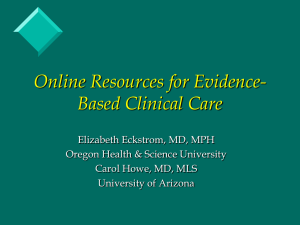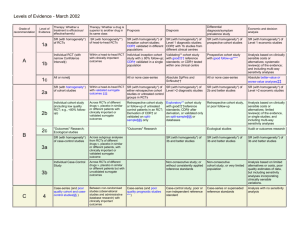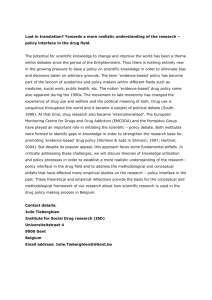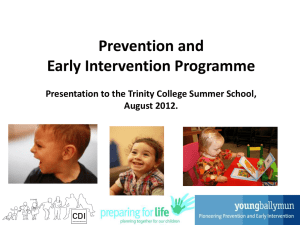file - BioMed Central
advertisement
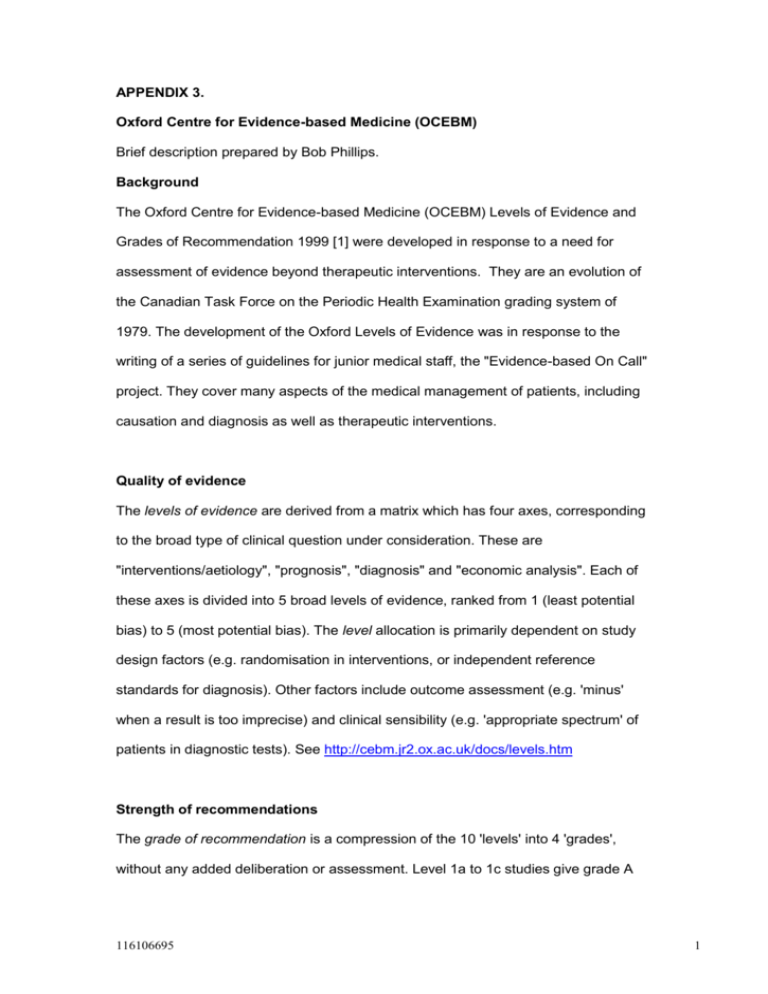
APPENDIX 3.
Oxford Centre for Evidence-based Medicine (OCEBM)
Brief description prepared by Bob Phillips.
Background
The Oxford Centre for Evidence-based Medicine (OCEBM) Levels of Evidence and
Grades of Recommendation 1999 [1] were developed in response to a need for
assessment of evidence beyond therapeutic interventions. They are an evolution of
the Canadian Task Force on the Periodic Health Examination grading system of
1979. The development of the Oxford Levels of Evidence was in response to the
writing of a series of guidelines for junior medical staff, the "Evidence-based On Call"
project. They cover many aspects of the medical management of patients, including
causation and diagnosis as well as therapeutic interventions.
Quality of evidence
The levels of evidence are derived from a matrix which has four axes, corresponding
to the broad type of clinical question under consideration. These are
"interventions/aetiology", "prognosis", "diagnosis" and "economic analysis". Each of
these axes is divided into 5 broad levels of evidence, ranked from 1 (least potential
bias) to 5 (most potential bias). The level allocation is primarily dependent on study
design factors (e.g. randomisation in interventions, or independent reference
standards for diagnosis). Other factors include outcome assessment (e.g. 'minus'
when a result is too imprecise) and clinical sensibility (e.g. 'appropriate spectrum' of
patients in diagnostic tests). See http://cebm.jr2.ox.ac.uk/docs/levels.htm
Strength of recommendations
The grade of recommendation is a compression of the 10 'levels' into 4 'grades',
without any added deliberation or assessment. Level 1a to 1c studies give grade A
116106695
1
recommendations; 2a to 3b map to grade B; level 4 studies are grade C and level 5
or imprecise ('minus' level) studies give a grade D recommendation.
Strengths and weaknesses
The strengths of the OCEBM approach are in the detailed development of the levels
of evidence. The different axes allow for questions related to diagnosis, aetiology and
prognosis to be considered as 'evidence-based' as well as traditionally interventionorientated recommendations. Another strength is in the partial incorporation of
aspects of heterogeneity into the grade of recommendation. The detailed description
of the study levels, and their objectivity, make reproducibility likely to be high.
However, this detail may introduce problems for inexperienced users. A study
estimating inter-tester reliability has been performed in the Oxford CEBM, and is
under analysis (Personal Communication: RSP).
The weakness of the OCEBM approach can be summarised as the simplistic
translation of level of evidence into grade of recommendation. No assessment is
made of the clinical importance of the outcomes under consideration. There is no
way of balancing of benefits or harms, nor assessment of applicability of the studies.
There is no clear way of compiling the body of evidence (often of separate levels)
into a single grade of recommendation, or differentiation of direct or indirect
evidence.
Target audiences
The OCEBM levels of evidence and grades of recommendation are intended to be
used by clinicians in practice. This approach is not intended for use by consumers or
policy makers.
Guidelines made with the use of this approach
116106695
2
The OCEBM approach has been used most extensively by "Evidence-based On Call"
to produce 37 guidelines in general (internal) acute medicine [2,3]. This project
develops guidelines which are focussed currently on the needs of the postgraduate
trainee clinician. The process is of systematic search of the literature, critical
abstraction, explicit allocation of a level of evidence and summary into a guideline,
with each statement given a summary grade of recommendation. All aspects of
management, from initial presentation, diagnosis, investigation, treatment and
prognostication are included in the guides.
The "Evidence-based On Call" internet system has recently been adopted by the UK
National Health Service National electronic Library of Health (NeLH) [4]. An
evaluation of user feedback and utilisation is planned.
Within the field of the project (guidelines in general acute medicine), the
homogeneity of the clinical environment and the secondary or tertiary nature of most
evidence used, ironed out some of the possible problems. Using the OCEBM
approach at a different level in the health care system (e.g. primary care, where
different populations are cared for) or across disciplines (e.g. with physiotherapists,
when different training and structures are present) may be difficult. We are not aware
of any group which has used the OCEBM grading system outside hospital medical
practice.
Studies evaluating the application of guidelines made with this approach
Formal evaluations completed:
None to date.
Formal evaluations underway or planned:
116106695
3
The NeLH evaluation may include aspects of audit against selected "Evidence-based
On Call" guidelines.
Informal evaluations:
Focus groups used during the development of the 'Evidence-based On Call' project
demonstrated a desire for such information. A number of clinicians working with the
developers of the "Evidence-based On Call" guidelines believed their practice had
been altered by the information presented.
References
1. http://cebm.jr2.ox.ac.uk/docs/levels.html - top
2. http://www.eboncall.co.uk
3. Ball, CM & Phillips, RS [Eds.] Evidence-based On Call; Acute Medicine. Harcourt
Brace 2001
4. http://www.nelh.nhs.uk
116106695
4
Levels of Evidence and Grades of Recommendations - 23 November 1999.
Grade of
Recommendation
Level of
Evidence
Therapy/Prevention, Aetiology/Harm
Prognosis
Diagnosis
Economic analysis
1a
SR (with homogeneityi) of RCTs
SR (with homogeneity*) of Level 1 diagnostic
studies; or a CPG validated on a test set.
SR (with homogeneity*) of Level 1 economic
studies
1b
Individual RCT (with narrow Confidence
Intervaliii)
SR (with homogeneity*) of
inception cohort studies; or a
CPGii validated on a test set.
Individual inception cohort study
with > 80% follow-up
Independent blind comparison of an
appropriate spectrum of consecutive patients,
all of whom have undergone both the
diagnostic test and the reference standard.
1c
All or noneiv
All or none case-seriesv
Absolute SpPins and SnNoutsvi
Analysis comparing all (critically-validated)
alternative outcomes against appropriate
cost measurement, and including a
sensitivity analysis incorporating clinically
sensible variations in important variables.
Clearly as good or better,vii but cheaper.
Clearly as bad or worse but more expensive.
Clearly better or worse at the same cost.
2a
SR (with homogeneity*) of cohort studies
SR (with homogeneity*) of Level >2 diagnostic
studies
SR (with homogeneity*) of Level >2
economic studies
2b
Individual cohort study (including low
quality RCT; e.g., <80% follow-up)
SR (with homogeneity*) of either
retrospective cohort studies or
untreated control groups in RCTs.
Retrospective cohort study or
follow-up of untreated control
patients in an RCT; or CPG not
validated in a test set.
Any of:
Independent blind or objective
comparison;
Study performed in a set of nonconsecutive patients, or confined to a
narrow spectrum of study individuals (or
both) all of whom have undergone both the
diagnostic test and the reference standard;
A diagnostic CPG not validated in a test
set.
Analysis comparing a limited number of
alternative outcomes against appropriate
cost measurement, and including a
sensitivity analysis incorporating clinically
sensible variations in important variables.
2c
“Outcomes” Research
3a
SR (with homogeneity*) of case-control
studies
Individual Case-Control Study
Independent blind comparison of an
appropriate spectrum, but the reference
standard was not applied to all study patients
Analysis without accurate cost
measurement, but including a sensitivity
analysis incorporating clinically sensible
variations in important variables.
A
B
3b
4
Case-series (and poor quality cohort and
case-control studiesviii)
Case-series (and poor quality
prognostic cohort studiesix)
Any of:
Reference standard was unobjective,
unblinded or not
independent;
Positive and negative tests were verified
using separate reference standards;
Study was performed in an inappropriate
spectrum** of patients.
Analysis with no sensitivity analysis
5
Expert opinion without explicit critical
appraisal, or based on physiology,
bench research or “first principles”
Expert opinion without explicit
critical appraisal, or based on
physiology, bench research or
Expert opinion without explicit critical
appraisal, or based on physiology, bench
research or “first principles”
Expert opinion without explicit critical
appraisal, or based on economic theory
C
D
“Outcomes” Research
“first principles”
116106695
6
1. These levels were generated in a series of iterations among members of the NHS R&D
Centre for Evidence-Based Medicine (Chris Ball, Dave Sackett, Bob Phillips, Brian
Haynes, and Sharon Straus).
2. Recommendations based on this approach apply to “average” patients and may need to
be modified in light of an individual patient’s unique biology (risk, responsiveness, etc.)
and preferences about the care they receive.
3. Users can add a minus-sign “-“ to denote the level of that fails to provide a conclusive
answer because of:
EITHER a single result with a wide Confidence Interval (such that, for example, an
ARR in an RCT is not statistically significant but whose confidence intervals fail to
exclude clinically important benefit or harm)
OR an SR with troublesome (and statistically significant) heterogeneity.
Such evidence is inconclusive, and therefore can only generate Grade D
recommendations.
i.
By homogeneity we mean a systematic review that is free of worrisome variations
(heterogeneity) in the directions and degrees of results between individual studies. Not all
systematic reviews with statistically significant heterogeneity need be worrisome, and not
all worrisome heterogeneity need be statistically significant. As noted above, studies
displaying worrisome heterogeneity should be tagged with a “-“ at the end of their
designated level.
ii.
Clinical Prediction Guide
iii.
See note #2 for advice on how to understand, rate and use trials or other studies with wide
confidence intervals.
iv.
Met when all patients died before the Rx became available, but some now survive on it; or
when some patients died before the Rx became available, but none now die on it.
116106695
7
v.
Met when there are no reports of anyone with this condition ever avoiding (all) or
suffering from (none) a particular outcome (such as death).
An “Absolute SpPin” is a diagnostic finding whose Specificity is so high that a Positive
vi.
result rules-in the diagnosis. An “Absolute SnNout” is a diagnostic finding whose
Sensitivity is so high that a Negative result rules-out the diagnosis.
vii.
Good, better, bad, and worse refer to the comparisons between treatments in terms of their
clinical risks and benefits.
viii.
By poor quality cohort study we mean one that failed to clearly defined comparison
groups and/or failed to measure exposures and outcomes in the same (preferably blinded),
objective way in both exposed and non-exposed individuals and/or failed to identify or
appropriately control known confounders and/or failed to carry out a sufficiently long and
complete follow-up of patients. By poor quality case-control study we mean one that
failed to clearly define comparison groups and/or failed to measure exposures and
outcomes in the same blinded, objective way in both cases and controls and/or failed to
identify or appropriately control known cofounders.
ix.
By poor quality prognostic cohort study we mean one in which sampling was biased in
favour of patients who already had the target outcome, or the measurement of outcomes
was accomplished in <80& of study patients, or outcomes were determined in an
unblinded, non-objective way, or there was no correction for confounding factors.
Abbreviations:
SR – Systematic review
RCT – Randomised Controlled Clinical Trial
CPG – Clinical Prediction Guide
ARR – Absolute Risk Reduction
Rx - Prescription
116106695
8
